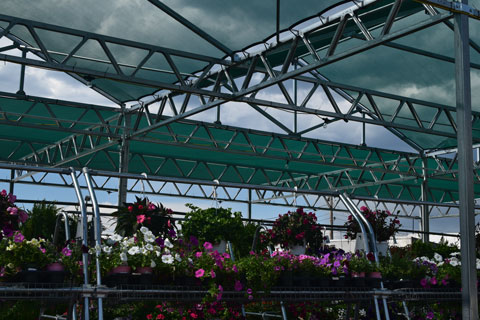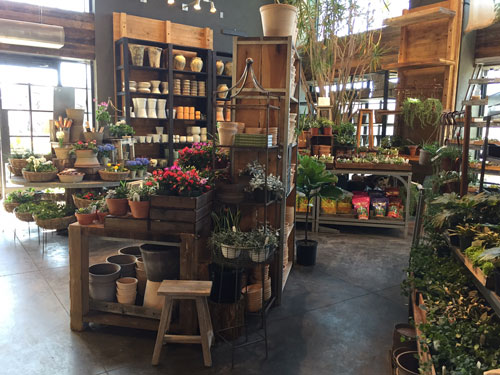8/1/2018
Your In-Store Fixer-Upper
John Johnston
The popularity of cable TV remodeling shows is astounding. It’s easy to get caught up in the excitement of all those dramatic home transformations! You can find examples of renovated garden centers and nurseries across the country, too.
Reading the news these days can be a painful reminder that retailing isn’t easy, even for those who have money to invest in their stores. Brick-and-mortar companies are under siege, competing for consumers who spend hours clicking away in their quest to find their purchases through pictures on websites and in catalogs.
When it comes to the gardening experience, you have to ask yourself this strategic question: What are you doing to get noticed? What changes are you making, internally and externally, to bring more “wow” factor to your customer’s attention?
Know When to Hold ’Em, Know When to Fold ’Em
Do you strive to make your store stand apart from competitors with amazing color, variety, convenience, unique displays and exceptional service? Do you plan far in advance to make changes? Or are you comfortable with what you’ve got? Are you a gambler? One of the great lines from Kenny Rogers’ song, “The Gambler,” is, “Every gambler knows that the secret to survivin’ is knowing what to throw away and knowin’ what to keep.” Retailing today must meet this challenge head on. Nothing stays the same.
In our industry, you have the ultimate weapon to use against box-store competitors: Color! Lots and lots of plant color. Growers make their living by maximizing table space on a continuous bench level, while retailers utilize various heights in creating excitement in colors, textures and combinations. Can customers see which plants you have to offer from the road at 40 miles per hour? What makes their heads turn? Color!
Showing fresh, healthy plants vertically sells far more than unorganized tables of moisture-deprived plants. Unhealthy plant displays kill sales opportunities, maybe forever, in the eyes of the ready-to-spend-now shopper. It takes manpower and daily maintenance to make your store displays look and sell their best. From the road, too many retailers continue to display their plants at one level. This display technique fails to tell the story of your second biggest weapon against the box stores: variety.
Putting the Custom in Customers’ Eyes
When it comes to table benching, carts, display hardware and signage, it’s best to budget a yearly spend to add, upgrade and maintain your assets. A little bit of attention paid to these details is often well worth it.
Displaying and strategically merchandising plants comes with a thought-provoking list of options from the ground up. Are we weed-free below the bench, with debris removed from the previous day? Check the bench table legs that are under the plants—do they need repair? After a few years of using chicken wire, pallets and wood planking, will they hold the weight of pots and trays after being filled to the max? Even when the pots are saturated?
Consistency in display materials is another visual consideration. If you must mix wood or resin types, try to group alike for specific plant categories or varieties. As you construct or move tables, look for safety concerns, such as cracked legs and frames, splinters, extruding screws and nails, or exposed wire.
Is your signage and pricing still intact and correct? If not, the price-driven questions from your customers will haunt you all day long.
Are there wagons or carts nearby for customers’ use? Consider providing two areas for access: one near the entrance for carts and another located centrally within the department or nursery yard.
Curbside Appeal & Your Identity
When times are tough, the first signs of cutting back expenditures involve advertising and manpower. Capital improvements take a backseat, too. Recouping business is much more difficult and costly than simply maintaining it.
In a retailer’s quest to create selling opportunities, there’s much to consider. First, prioritize the best avenue to get your store noticed. You may be surprised to hear the answer doesn’t have to include paid advertising.
Adding a greenhouse gives instant recognition that you’re the grower. It may be a long-term improvement, but one that pays extra dividends in offering an advantage of a covered shopping environment. A new structure comes with the added bonus of more holding power for hanging baskets—more color, more sales opportunities. Consider what’s best for your circumstances.
Installing a V-truss shade system offers your store increased height and visibility from the street, expanded holding capacity for hanging baskets and a shade cloth that not only protects the plants, but offers your customer reduced ambient temperatures underneath while shopping during hot, sunny days. Shade systems can also reduce water consumption, which can save money if you’re using city water.
 New Ownership, New Look
New Ownership, New Look
One recent example of a V-truss addition happened in New Jersey at Magnolia Garden Village in 2016. After taking ownership of a 50-year-old business, Pat Conahan felt customers were seeing the same drive-by views year in and year out, and the stale look was driving a steady decline in traffic and sales for more than a decade.
Pictured: Magnolia Garden Village upgraded with a new V-truss system from Poly-Tex, which also houses these hanging basket merchandising systems.
Pat’s capital improvements over two years included new benching, expansion of the street-side plant yard, addition of a V-truss system from Poly-Tex, increasing his fleet of plant carts—including two-tier types for extra holding power—recycled wood interior walls and renovating bathrooms. The return on his investments is paying off. Customers are amazed at the amount of offerings shown inside and out. The biggest change is his “exposure” to the traffic moving quickly out front. They can’t help but turn their heads and put on the brakes for the massive amount of color that influences them from a 1,000 ft. down the road. That’s about 15 seconds of “wow” exposure!
 Imitation May Mean More Sales
Imitation May Mean More Sales
Terrain, the standalone gardening brand of Urban Outfitters, may only have four stores nationwide, but the brand has proven very influential among garden centers. Terrain stores feature a common theme of natural, organic, re-purposed, recycled materials merchandised to appeal to the female shopper, ages 25 to 45.
Pictured: Terrain’s four locations specialize in effectively using natural materials to contrast with the plants.
Using their corporate backing, Terrain has fine-tuned its talented staff, optimized its website, added more store-driven events, sourced unique products globally and provided a great meeting spot for friends to shop while enjoying a cup of coffee or espresso.
Whatever your opinion is about Terrain and Urban Outfitters, they’re raising the bar on staging products, merchandising with a purpose and bringing a new awareness to what’s possible in our industry. The current resurgence in using natural woods in retail displays offers a contrasting backdrop for our colorful packaging and plants; it enables products to jump out at you.
The trend toward natural display materials also forces you to consider new means of increasing light levels in your store when using darkened surfaces. Many retailers continue their lighting conversions from incandescent to LED options, to save money on energy bills and increase product awareness within displays.
There’s no shortage of inspiration for your in-store “fixer upper.” With so many options to increase visibility for your store, which ones will you explore first? GP
John Johnston is Retail Education Manager for Griffin. He can be reached at jjohnston@griffinmail.com.